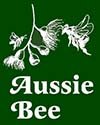A NATIVE BEE ALTERNATIVE FOR CROP GROWERS:
BLUE BANDED BEES
Aussie Bee > Bumblebee Problem > Blue Banded Bees -- as Alternative Native Bee Pollinators
Other Aussie Bee reports on the Bumble Bee problem:
-- Debate on using exotic bumblebees in Australia
-- How to identify a feral bumblebee
-- Have you seen a bumblebee on the Australian mainland?
-- What harm could feral bumblebees cause?
-- How far could feral bumblebees spread in Australia
-- Bumblebees and invasive weeds in Australia
Horticulturalists have been lobbying for many years to introduce European Bumblebees to Australia for crop pollination. Two Bumblebee import applications by horticulturalists in 1997 and 2004 have already been rejected by the Government because of the risk that exotic Bumblebees pose to Australian farms and bushland.
Bumblebees are used in many overseas countries to pollinate greenhouse crops such as tomatoes, cucumbers and eggplants. However, an Australian native bee alternative pollinator is available: the Blue Banded Bee!

A native Australian Blue Banded Bee, Amegilla, Buzz Pollinating a tomato flower inside a greenhouse
This native bee could be an effective and practical solution for the tomato growers. Researchers at the University of Adelaide have shown that the Australian Blue Banded Bee, Amegilla:
-- Can be bred year-round in large numbers;
-- Actively forages on greenhouse tomato crops throughout the temperature range used in Australian commercial greenhouses; and
-- Produces tomatoes 15-20% heavier than those that are currently produced by growers using their conventional vibration wand pollination system.
The importation of foreign Bumblebees should not even be considered when a promising native bee alternative is available!
Some husbandry issues with the Bluebanded Bee still need to be solved. However, the research has only received limited funding so far. Instead of continually lobbying for the introduction of exotic Bumblebees, the horticultural industry should support the development of this Australian native bee alternative pollinator.
Read More about the Research to Develop Blue Banded Bees for Greenhouse Crop Pollination:
-- Adelaide University research update in 2012.
-- Adelaide University research update in 2008.
-- Adelaide University research update in 2006.
-- Aussie Bee Online, article 10 (2006): Blue Banded Bee Pollination Trials at Adelaide University
-- Aussie Bee Online, article 9 (2006): Tomato Pollination with Blue Banded Bees: The Results Are In!
-- Aussie Bee Online, article 2 (2001): Blue Banded Bees - Potential Pollinators of Glasshouse Tomatoes
Other Aussie Bee reports on the Bumble Bee problem:
-- Debate on using exotic bumblebees in Australia
-- How to identify a feral bumblebee
-- Have you seen a bumblebee on the Australian mainland?
-- What harm could feral bumblebees cause?
-- How far could feral bumblebees spread in Australia
-- Bumblebees and invasive weeds in Australia



